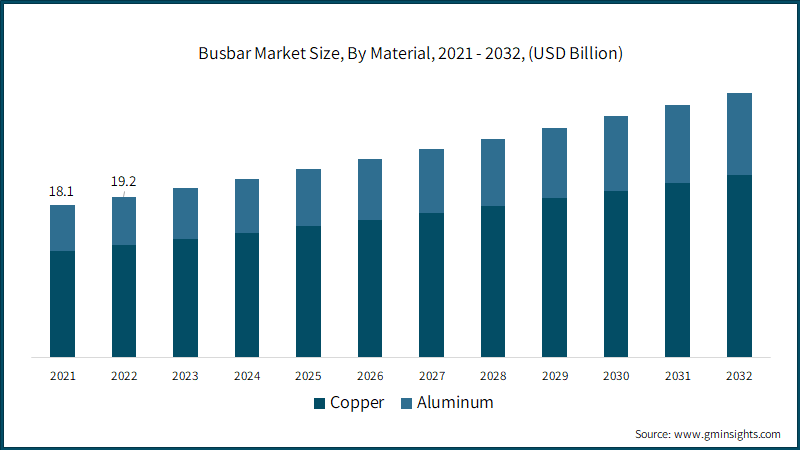Home > Energy & Power > Wire and Cable > Power Cable > Busbar Market
Busbar Market Analysis
- Report ID: GMI2399
- Published Date: May 2023
- Report Format: PDF
Busbar Market Analysis
copper busbars were already widely used in various industries due to their excellent electrical conductivity, thermal properties, and mechanical strength. Copper busbars have been traditionally employed in power distribution systems, switchboards, electrical panels, and other applications where efficient power transmission is crucial. Aging power infrastructure in many countries demands modernization to ensure reliability and efficiency. Copper busbars are often chosen for upgrading electrical systems due to their compatibility with existing infrastructure and their ability to handle higher power loads.
Busbar market from aluminum segment is set to expand at more than 6% CAGR through 2032. Aluminum busbars have gained significant popularity in various industries due to their advantageous properties such as lightweight, high conductivity, and cost-effectiveness compared to traditional copper busbars. While copper remains a widely used material for busbars, aluminum has been steadily gaining traction in the market.
In addition, aluminum is significantly lighter than copper, which is particularly advantageous in applications where weight is a concern, such as in electric vehicles (EVs) and aerospace industries. The use of aluminum busbars helps reduce the overall weight of these systems and improves energy efficiency. Moreover, aluminum is a highly recyclable material, and its production requires less energy compared to copper. As sustainability and environmental concerns continue to grow, the use of aluminum busbars aligns with the goal of reducing carbon footprints and promoting a circular economy.

Commercial application accounted for over 43% of global market share in 2022. Increasing electricity demand on account of rapid urbanization and commercialization will propel the business landscape. In addition, introduction of energy conservation programs to enhance energy efficiency across commercial establishments including business centers and shopping complexes will further enhance industry growth.
Industrial busbar market share will witness surge owing to positive outlook toward manufacturing industry along with strong economic growth. Increasing foreign direct investments toward electricity distribution & generation coupled with rising public and private funding in development of infrastructure will further complement the business landscape. In addition, rapid industrialization, particularly in developing countries, has been a significant driver for the industrial busbar industry. As new manufacturing plants, commercial buildings, and infrastructure projects are being established, the need for efficient power distribution systems like busbars has risen.

The U.S. market will witness growth on account of favorable measures to replace the conventional power supply systems from energy efficient technologies to reduce transmission losses. Ongoing technological innovations in the structural integrity of conductors to reduce installation time & complexity, maintain electrical flow, enhance efficiency, will further complement the industry dynamics.
Growing adoption of high voltage transmission networks to cater for the continual increase in the electricity demand will accelerate the Europe busbar market size. Furthermore, increased in investments toward development of energy infrastructure project to support electricity generation units will further complement the business growth.

